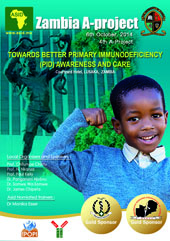Elfeky R1, Radwan N1, Hassanein SM2, Reda SM1
1 Paediatric Allergy and Clinical Immunology Unit, Children’s Hospital, Faculty of Medicine, Ain Shams university, Cairo, Egypt.
2 Paediatric Neurology Unit, Children’s Hospital, Faculty of Medicine, Ain Shams university, Cairo, Egypt.
Traduit par L Jeddane
Contexte: Le syndrome de Griscelli type 2 (GS2) est une maladie rare induite par des mutations dans le gène RAB27A et caractérisée par une hypo-pigmentation oculo-cutanée et un déficit immunitaire cellulaire variable1. Des cheveux argentés avec de larges mélanosomes en mottes à l’examen microscopique de la tige posent le diagnostic. La complication la plus fréquente représentant un facteur de mortalité est la prolifération lymphohistiocytique dans de nombreux organes, y compris le cerveau2. La maladie est fatale, en l’absence de greffe de cellules souches hématopoïétiques. L’âge de présentation et la sévérité de la maladie varie parmi les membres d’une même famille. Les garçons peuvent présenter une maladie plus sévère que le filles. Le recours à l’IgIV peut retarder le développement du HLH dans le GS2.
Dr I. Benhsaien
Unité d’Immunologie Clinique, Hôpital A. Harouchi, Casablanca, Maroc
Contexte : Le syndrome de Chediak-Higashi (CHS) est caractérisé par un albinisme oculocutané partiel, un déficit immunitaire et une tendance au saignement. Ces signes résultent d'anomalies fonctionnelles des polynucléaires contenant de grosses inclusions lysosomales caractéristiques et d'un déficit des lymphocytes NK (Natural Killer). La transmission est de type autosomique récessif. Le gène CHS a été localisé sur le bras long du chromosome 1, en 1q42.1-q42.2. Une fois suspecté, le diagnostic est basé sur la présence de granules dans les globules blancs sur le frottis sanguin.
Dr I. Benhsaien
Clinical Immunology Unit, Hospital A. Harouchi, Casablanca, Morocco
Translated by L. Jeddane
Background: The Chediak-Higashi syndrome (CHS) is characterized by partial oculocutaneous albinism, immunodeficiency and bleeding tendency. These signs result from functional anomalies of polymorphonuclears containing characteristics large lysosomal inclusions and a functional defect of NK cells (Natural Killer). Transmission is autosomal recessive. CHS gene was localized on the long arm of chromosome 1, 1q42.1-q42.2. Once suspected, the diagnosis is based on the presence of granules in the white blood cells on the blood smear.
Dr Erwa N. H. H.1, 2, Dr Al Hussain H. A. 2Dr A Aziz S. I. 1, 2 & Prof Ahmed A. H.1
1 Faculty of Medicine University of Khartoum, Khartoum Sudan
2 Soba University Hospital, university of Khartoum, Khartoum, Sudan
Common Variable Immunodeficiency (CVID) represents a heterogeneous group of primary antibody deficiencies (PADs) which is increasingly becoming a diagnosis of exclusion. The diagnosis is based on a clinical presentation of repeated infections mainly of the respiratory tract and decreased immunoglobulins of the IgG, IgA with or without a decrease in the IgM isotype1,2. Infections are usually bacterial and viral whereas fungal infections are unusual as primary pathogens in patients with primary antibody deficiency unless there is a substantial T cell defect 2, 3. While many immunological defects have been reported in CVID patients, primary Aspergillus infection is not commonly seen in this group of patients 3.



























